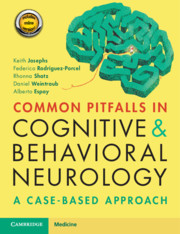Book contents
- Common Pitfalls in Cognitive and Behavioral Neurology
- Common Pitfalls in Cognitive and Behavioral Neurology
- Copyright page
- Dedication
- Contents
- Diseases Discussed in the Book
- Preface
- Acknowledgements
- Abbreviations
- Part 1 Missing the Diagnosis Altogether
- Part 2 Misidentifying the Impaired Cognitive Domain
- Part 3 Missing Important Clues in the History
- Part 4 Failure of Pattern Recognition
- Part 5 Difficult-to-Characterize Cognitive/Behavioral Disorders
- Part 6 Clinical Findings That Are Subtle
- Part 7 Misinterpreting Test Results
- Part 8 Attributing Findings to a Known or Suspected Disorder
- Case 36 “I Have Snored All My Life and It Never Affected My Work”
- Case 37 Starting Early
- Case 38 “I Have Been Taking the Same Medications for Years”
- Case 39 Cognitive Impairment and Blood Pressure Fluctuations
- Case 40 Corticobasal: The Syndrome versus the Pathology
- Part 9 Missing Radiographic Clues
- Part 10 Management Misadventures
- Index
- Plate Section (PDF Only)
- References
Case 37 - Starting Early
from Part 8 - Attributing Findings to a Known or Suspected Disorder
Published online by Cambridge University Press: 03 November 2020
- Common Pitfalls in Cognitive and Behavioral Neurology
- Common Pitfalls in Cognitive and Behavioral Neurology
- Copyright page
- Dedication
- Contents
- Diseases Discussed in the Book
- Preface
- Acknowledgements
- Abbreviations
- Part 1 Missing the Diagnosis Altogether
- Part 2 Misidentifying the Impaired Cognitive Domain
- Part 3 Missing Important Clues in the History
- Part 4 Failure of Pattern Recognition
- Part 5 Difficult-to-Characterize Cognitive/Behavioral Disorders
- Part 6 Clinical Findings That Are Subtle
- Part 7 Misinterpreting Test Results
- Part 8 Attributing Findings to a Known or Suspected Disorder
- Case 36 “I Have Snored All My Life and It Never Affected My Work”
- Case 37 Starting Early
- Case 38 “I Have Been Taking the Same Medications for Years”
- Case 39 Cognitive Impairment and Blood Pressure Fluctuations
- Case 40 Corticobasal: The Syndrome versus the Pathology
- Part 9 Missing Radiographic Clues
- Part 10 Management Misadventures
- Index
- Plate Section (PDF Only)
- References
Summary
This 51-year-old right-handed woman had experienced cognitive decline for 8 years. Her husband first observed that she had difficulties finding and pronouncing words correctly (e.g., saying bindow instead of window). In addition, she had become increasingly forgetful. Her ability to communicate steadily declined, and for the past 18 months she has been unable to sustain a meaningful conversation. Although she occasionally could retrieve appropriate words, her speech often consisted of nonwords. She did not follow verbal commands, but she was able to imitate and repeat short, single words intermittently. She spent hours in front of a mirror talking to herself. She remained affectionate toward her husband and was fully dependent on him for her basic activities of daily living (i.e., feeding, bathing). She did not endorse depression or anxiety but was easily irritated. Gait was preserved with no falls. A trial of donepezil 5 mg daily years ago was discontinued due to worsening irritability. Her father was diagnosed with dementia in his forties and died at age 52. She had two older sisters and two daughters with no neurological symptoms.
- Type
- Chapter
- Information
- Common Pitfalls in Cognitive and Behavioral NeurologyA Case-Based Approach, pp. 115 - 118Publisher: Cambridge University PressPrint publication year: 2020



